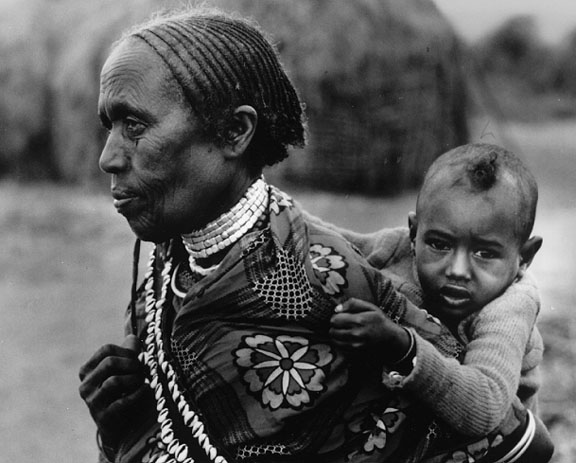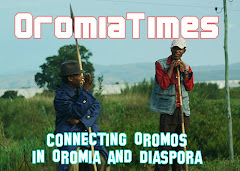After decades of drought, famine, repression and war, Ethiopians are preparing for more of the same.
By Martyn Drakard
Ethiopia, the fabled home of the Queen of Sheba, is a striking contrast of landscapes. It is partly traversed by the Great Rift Valley, which extends from Lebanon to Mozambique. Its jagged, lush mountains make it a kind of huge fortress surrounded by forbidding desert, which is one reason why it has been isolated from much outside influence and has gone its own way. Even the scramble for Africa in the 19th century by European colonial powers left it unscathed. Together with the other countries of the north-east, Sudan, Eritrea and Somalia, it makes up the Horn of Africa. It still holds fast to its centuries-old ways and is quite different from east and central Africa -- the Africa as imagined by the outside world -- which starts on its doorstep.
Ethiopia was evangelised very early –- some say by St Matthew, the Apostle -- and has preserved its brand of Coptic Christianity, with its rock churches, distinctive religious images, lengthy oriental ceremonies and a liturgical language, Ge’ez. The country was the only long-lasting Christian enclave within Africa until the era of evangelization began, but is now 50 per cent Muslim. Apart from the Italian invasion in the 1930s, the country was left alone under its emperors. The last emperor, the famous Haile Selassie, the Lion of Judah, was murdered by the thugs of Mengistu Haile Mariam, a Soviet-backed puppet who ousted him and his US supporters, at the cost of widespread bloodshed. The famine of the early 1980s, politically motivated and abetted by a drought, brought heart-wrenching images of skeletal mothers and babies to TV sets around the world. And after that Ethiopia was forgotten again.
Islamic threat
In the last few weeks, however, Ethiopia has been “technically at war” with neighbouring Somalia, according to its president, Meles Zenawi, who has become a pawn in the proxy war to restrain the terrorist threat to the West. From a Western point of view, the current Ethiopian government is a Christian buffer against aggressive Islamic expansion, specifically against the radical elements within the Union of Islamic Courts, which is effectively in control of Somalia. From a Muslim point of view, it is “the leader of a US-backed assault on a Muslim country”, since Ethiopia is the only country openly giving strong support to the transitional Somali government in Baidoa.
This is not the first time that Ethiopia and Somalia have gone to war. In 1977 Somalia managed to advance quite far inside Ethiopia before being turned back. Both were using tanks given by the Soviet Union. Now, the conflict could reach much further.
The Somali Islamists are well supplied with weapons from sympathetic countries in the region, despite an arms embargo, and by Ethiopia’s enemy to the north, Eritrea, with which there has been a long-running border dispute, which erupted into a two-year war in 1998.
Ethiopia would be a formidable foe. Its rapid population explosion -- it now has nearly 80 million people and by the year 2050 will be one of the 10 largest nations in the world -- has been accompanied by a big military build-up. The National Defence Army has between 120,000 and 150,000 men, with massive stocks of hardware. This includes Soviet-made tanks, heavy artillery, and rocket launchers -- all still in good condition, according to Jane’s Defence Weekly. The army has also received training, logistics, transport and direct sales of hardware from the United States.
But Ethiopia has its own internal problems, not least of which is the 30 million-strong Oromo people. Colonised by King Menelik in 1887, the Oromo still want their territory, Oromiya, to be liberated. The Oromo Liberation Front is a powerful force and carries out a low-key but persistent guerilla campaign against the national forces. The Oromo are mainly Muslim.
Further north, another group, the Ogaden National Liberation Front (ONLF) is pressing for self-determination, and has sided with radical Islamists in the past. The Ogaden is an extensive dry area bordering Somaliland and Puntland, and home to 4 million Ethiopian Somalis. Together with half a dozen other groups, they are taking up arms against the Zenawi regime, which they find has gradually become more and more repressive. In their turn, some Somali hardliners threaten to create a greater Somalia, an Islamic emirate, which will incorporate the Somali parts of Ethiopia and Kenya.
Zenawi loses his nerve
But hardliners are to be found not only in Somalia. The Zenawi regime is cracking down on any perceived form of opposition; it seems that Soviet-style tactics have not altogether disappeared. During the late 70s and early 80s tens of thousands of Ethiopians, many of them students, were killed or interned. Zenawi has been a progressive leader; he reduced poverty, built schools, health clinics and roads, and extended the national grid.
But recently he has been losing his nerve. Last year there were the street protests in the wake of a disputed general election. Opposition leaders, journalists, activists and some professionals were arrested and some were charged with treason. The treason trial has become an embarrassment to the donor countries of the West. Should they support a repressive regime or should they leave an ally alone to face an Islamic onslaught and possibly lose a strategic base in a hostile region?
A further embarrassment is the independent commission set up to rule on the killings. Although the commission members were appointed by the Government, their findings turned out to be truly independent. The majority decided that the government had used excessive force and claimed that the president had tried to make them reverse their decision. According to their findings nearly 200 people were killed, mainly by security forces. Many other young people are said to be in labour camps, which the Government has vehemently denied.
Now the commission head and his deputy have fled the country in fear for their lives. The government is spending more on the secret police. Email is monitored and opposition websites have been blocked. Calendars with pictures of detained opposition leaders are in wide circulation, often going for many times their price.
The President could be losing his grip as well as his nerve, and so is resorting to extreme measures; and basic human freedoms are the first to slowly disappear or become clouded. After the bloodthirsty nightmare of the Mengistu regime, Ethiopia changed direction and was making good headway. It would be a pity if those gains were to be lost overnight. As experience of many other states in this region has shown, repression –- a system to ensure the breeding of an enemy within -- is not the best way to keep a country together in the face of a common enemy from outside.
Martyn Drakard is MercatorNet's African Contributing Editor. He writes from Nairobi.
www.mercatornet.com
Subscribe to:
Post Comments (Atom)



No comments:
Post a Comment